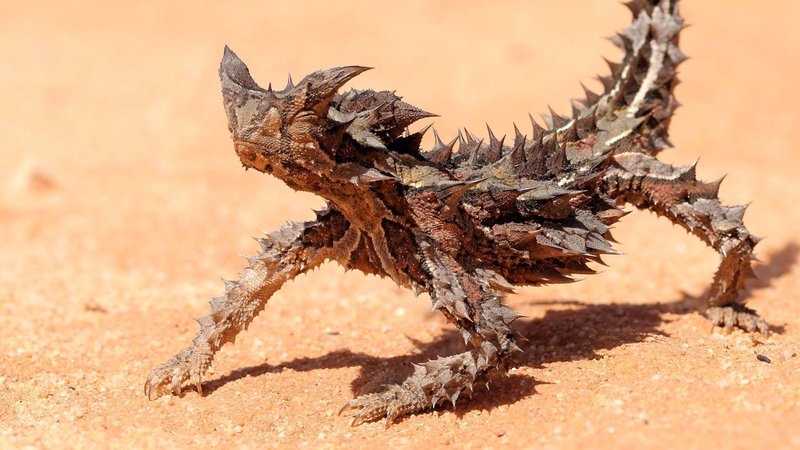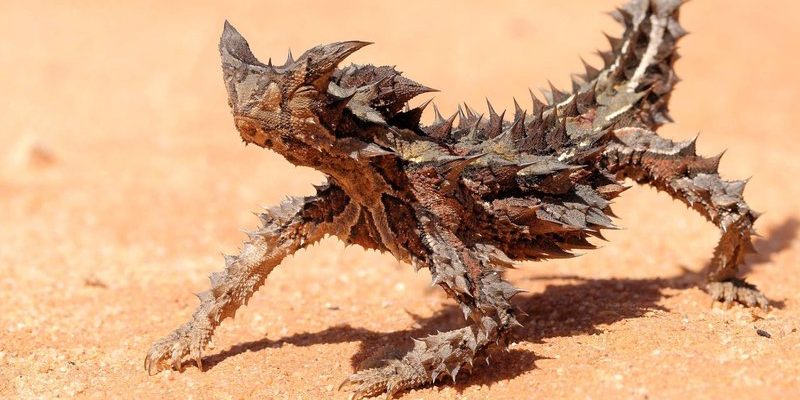
The Thorny Devil, also known as the Moloch horridus, is one of Australia’s most unique lizards. Imagine a creature so cleverly disguised that it looks like a spiky ball of thorns. This quirky reptile has evolved to thrive in the harsh deserts of Australia, showcasing nature’s creativity in adaptation. The Thorny Devil has garnered attention not only for its unusual appearance but also for its fascinating behaviors and survival tactics. It’s a true wonder of the animal kingdom!
What makes the Thorny Devil stand out? To begin with, it utilizes its remarkable spiky exterior as a defense mechanism against predators. When threatened, it can even mimic a dead leaf, blending seamlessly into its environment. This bizarre lizard isn’t just a pretty face, though; it has some pretty interesting tricks up its sleeve, like a unique way of drinking water. So, whether you’re an animal enthusiast or just curious about this enchanting creature, let’s dive deep into the world of the Thorny Devil.
Physical Characteristics
The Thorny Devil is a small lizard, measuring about 20 to 25 centimeters in length. Its skin is covered in sharp, thorn-like spikes that provide excellent camouflage and protection against predators like birds and snakes. The body is a delightful mix of earthy colors—mostly browns and tans—allowing it to blend in beautifully with its desert surroundings. Picture it lounging on a sun-soaked rock, practically invisible to any passerby!
One of the most distinctive features of the Thorny Devil is its “horns.” The two prominent horns atop its head serve as an extra layer of defense, making it look even more fearsome to would-be predators. Interestingly, these lizards have been designed by evolution to have incredible flexibility in their skin, allowing them to expand and contract as they absorb water. Their remarkable ability to store moisture is a clever adaptation to their arid habitat.
Habitat and Distribution
Thorny Devils are native to Australia, primarily found in the arid deserts and scrublands of the continent. These fascinating lizards prefer sandy or rocky terrains where they can easily camouflage themselves from predators. You might find them basking in the sun during the day, absorbing heat before retreating to shady areas to avoid overheating. Their keen adaptation to hot climates allows them to thrive in temperatures that would leave many other creatures seeking shelter.
These creatures are highly territorial and tend to stay within a limited range, living in areas where food sources are abundant. In terms of distribution, Thorny Devils have been spotted across a variety of Australian states, including Western Australia, South Australia, and the Northern Territory. Here’s a fun fact: the Thorny Devil can often be spotted during the warmer months when they are most active, making summer a great time to witness their unique behaviors.
Diet and Feeding Habits
The Thorny Devil’s diet primarily consists of ants. Yes, you heard that right—these spiky creatures are picky eaters! They feast on various species of ants, consuming thousands in a single meal. To catch their tiny prey, they employ a clever hunting method. With a flick of their long, sticky tongues, they snatch up ants as they scurry by. It’s like a mini circus act right in the Australian desert!
Interestingly, Thorny Devils are not only skilled insect hunters but also have a specialized feeding mechanism. They can drink water through a unique process, allowing them to absorb moisture directly from the environment. When it rains, the Thorny Devil has been observed to tilt its body to catch droplets that run down its skin, directing the water into its mouth. Talk about an ingenious way to hydrate!
| Characteristic | Details |
| Size | 20-25 cm in length |
| Weight | Approximately 50-150 grams |
| Habitat | Arid desert and scrublands of Australia |
| Diet | Mainly ants |
| Defense Mechanism | Camouflage and spiky exterior |
| Lifespan | Up to 20 years in captivity |
Behavioral Traits
The Thorny Devil exhibits several interesting behaviors that set it apart from other lizards. One of the most captivating aspects is its method of self-defense. When threatened, the Thorny Devil can flatten its body and roll into a ball, making it appear even more intimidating and difficult to handle. This, paired with its spiky exterior, makes it a less appealing meal for hungry predators.
These lizards also communicate through subtle behaviors, which might go unnoticed by most. For instance, they can change their body posture depending on their mood or environmental conditions. When feeling threatened, they may puff up or display their spikes more prominently, while a relaxed Thorny Devil might adopt a more laid-back posture. This form of non-verbal communication gives them a way to signal to both predators and potential mates.
Reproduction and Lifecycle
The mating season for Thorny Devils typically occurs from late spring to early summer. During this time, males engage in elaborate courtship displays to impress females. These displays can include head-bobbing, color changes, and even wrestling. The female Thorny Devil lays between 2 to 10 eggs in a concealed burrow, ensuring they have some protection from predators during development.
Once the eggs hatch, baby Thorny Devils are fully independent and must fend for themselves right away. The tiny hatchlings, measuring around 5 cm, are miniature versions of their parents and are equipped with the same impressive camouflage and defense mechanisms. They will grow quickly, often reaching maturity in just a year or two. The entire lifecycle—from hatchling to adult—shows how resilient and adaptable these lizards truly are.
Conservation Status
As of now, the Thorny Devil is classified as a species of least concern, which means they are not currently at risk of extinction. However, this doesn’t mean they face no threats at all. Habitats are increasingly affected by climate change and human activities, potentially disrupting their environments and food sources. Awareness about their natural habitat and needs is crucial to ensuring their longevity in the wild.
Moreover, conservation efforts play a vital role in supporting the natural habitats of the Thorny Devil. Engaging in responsible tourism and supporting initiatives that promote habitat preservation can help protect these unique lizards for future generations. Remember, when you learn about the Thorny Devil, you’re also becoming an advocate for its preservation!
FAQ
What is the lifespan of a Thorny Devil in the wild?
In the wild, Thorny Devils typically live around 5 to 7 years. However, when kept in captivity under optimal conditions, they can live up to 20 years. Their lifespan in nature can be influenced by factors like predation, food availability, and environmental conditions.
Are Thorny Devils venomous?
No, Thorny Devils are not venomous. Their defense relies on their spiky appearance and camouflage. They do not pose a threat to humans or larger animals, preferring to avoid confrontation whenever possible.
How do Thorny Devils drink water?
Thorny Devils have a unique ability to absorb water through their skin. They can tilt their bodies to catch rainwater that runs down their spikes, directing it into their mouths. This adaptation helps them survive in dry environments.
What predators do Thorny Devils face?
Thorny Devils face a few natural predators, including birds of prey, snakes, and larger lizards. Their primary defense is their camouflage and spiky exterior, making them less appealing targets for predators.
Can Thorny Devils be kept as pets?
While Thorny Devils can be kept as pets, they require specific care and habitat conditions to thrive. Potential owners should research and prepare for their unique diet and environmental needs before considering them as pets.
Do Thorny Devils have any social structure?
No, Thorny Devils are solitary creatures. They tend to be territorial and prefer to live alone unless during the mating season. Their interactions primarily occur between potential mates or during disputes over territory.
What colors do Thorny Devils come in?
Thorny Devils primarily exhibit earthy colors, like browns, tans, and yellows, which help them camouflage in their desert habitats. Some individuals may have variations in shades, but their overall appearance remains consistent with their natural environment.
Where can I find Thorny Devils in the wild?
You can find Thorny Devils throughout Australia, particularly in arid regions like deserts and scrublands. They are most active during the warmer months, making summer an ideal time for spotting these fascinating lizards in their natural habitat.
How do Thorny Devils contribute to their ecosystem?
Thorny Devils play a vital role in their ecosystem by controlling ant populations. By consuming thousands of ants, they help maintain a balance within their environment. This contributes to the overall health of their habitat and aids in nutrient cycling.
Are Thorny Devils endangered?
Currently, Thorny Devils are not considered endangered; they are listed as a species of least concern. However, habitat destruction and climate change pose potential threats to their populations, making continued conservation efforts essential.

